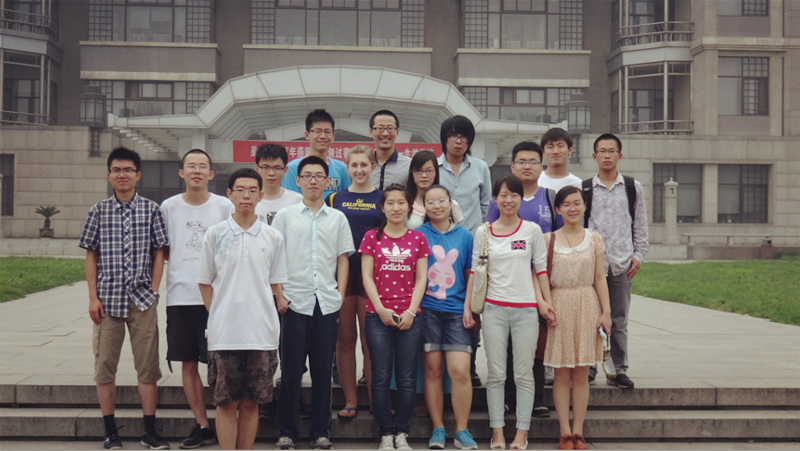Team:Peking/HumanPractice/iGEMWorkshop
From 2013.igem.org
Team Communication

To promote communication between iGEM teams, we held a gathering, to provide a chance for teams from different universities of China to introduce their projects. Furthermore, we did several things to help XMU iGEM team, BIT iGEM team and OUC iGEM team. We also held a workshop to inspire high school iGEM team from Beijing No.12 Middle School.
Helping Other Teams
1.We provided sfGFP Biobrick for XMU iGEM team.
2.We helped BIT perform Microplate Reader test.
3.We provided competent cells (E.coli strain DB.31) that we prepared previously, to OUC iGEM team.




Inspiring HS Team
Last summer, Peking iGEM team guided high school students in Beijing towards future participation in iGEM HS Division, by forming alliance with official organizations in Beijing to make it a long-term program, giving series of quality lectures introducing Synthetic Biology & iGEM to high school students, analyzing HS students' situation through quantitative data, and teaching HS students directly to prepare them for iGEM in 2013, both theoretically & experimentally. This project is entitled Sowing Tomorrow Synthetic Biologists, and is inherited by 2013 Peking iGEM team.



It seems school students would be more likely to be interested in synthetic biology. So we are interested in the idea of inspiring young high school students to learn more about synthetic biology and our project. On July 18, high school students from Beijing No.12 Middle School came to visit our lab.
If you can't view this video, please click here.
When they were visiting our lounge and lab, we introduced ourselves and our best friends, our experimental apparatus to them. We gave the high schoolers straight forward visual explanations of our lab equipment, such as having them observe Nanodrop drop changes.
We discussed their project, and guided them through primer design. Moreover, we recommended a circuit to them and described different RBS.
This was an opportunity to share our ideas about synthetic biology with them, including the application design and the iGEM competition. We addressed the significant role public media and public choice played. But we had to admit the potential biosafety problems and limitations of genetically engineered bacteria.
We played a little game with them, to compete in brainstorming various potential designs for biosafety. Obviously, they are encouraged by this interesting part and came up with several wonderful ideas. We hope they would popularize this game and, more importantly, safety ideas behind it. Then we may make another enormous stride in convincing people that synthetic biology is not as dangerous as they originally think.
We then introduced our project to them, including the serious environmental impacts of toxic aromatic compounds. It was the right time to emphasize the necessity of public concern and public scrutiny in environmental problems.
We also offered direct help with their experiments. We introduced gel electrophoresis, four kinds of restriction enzymes, and standard assembly. At last, we showed them how to use iGEM parts and provided them with iGEM parts E0840, B0015, J23100, and J23106.
Model iGEM
In September 7th, the first Model iGEM was hosted by Peking iGEM. Focusing on inter-team communication, preparing for iGEM jamboree but not for prize, Model iGEM is a competition without competitiveness.
If you can't view this video, please click here.
We believe, that interactions bring great insights. And we all think it was a really unique, fantastic experience. We hope other iGEM teams would be inspired to do the same, and Model iGEM will be continued to be hosted in the years after.
For several team members, it will be their first time to attend iGEM Asian Jamboree in this October. Model iGEM could be seen as a “drill” in advance, from presentation to poster. We wanted the competition to work like the Asian Jamboree as much as possible, in the meanwhile, promote the communication between teams.
However, it was inappropriate and unnecessary to award any prize, for few teams had adequate time to get ready in early September.
Plans
Opening Ceremony
8:40 a.m. Opening Remarks by Dr. Chunbo Lou
Presentation Competition
9:15- 9:45 Pre of Peking
9:45- 10:15 Pre of BIT
10:15-10:45 Pre of Fudan
10:45-11:00 Tea break
11:00-11:30 Pre of NJU-China
11:30-12:00 Pre of Tianjin
12:00-12:30 Pre of OUC-China
Each team has 20 minutes for presentation, 5 minutes for Q&A and another 5 minutes for team-switching during Presentation Competition.
Poster Competition
12:30-14:00 Lunch at posters
Closing Ceremony
14:30-15:30 Closing remarks by Haoqian Zhang
Team communication and group photo-taking
Snap shot
Concentrating on ideas from different teams, we really enjoyed our time. Strengths and weaknesses, we sometimes saw in ourselves and sometimes from others. Wonderful questions from audiences and judges pointed out how to improve and present our projects in the future, so did advice.


Having experienced a model competition, we owned a chance to view our project as an outsider. And we believe that, we will be much more at ease in the presentation of Asian jamboree.

As for lunchtime, we enjoyed the tasty pizza and our talk. We shared funny stories in this summer and exchanged ideas about different projects as well as teams. Walking around, we viewed posters from each team, and discussed curves, data, even details about materials and test conditions.

Eventually, closing remarks approached. Tired but joyful, we will never forget this rewarding model jamboree.
Click here to view the brochure of the Model iGEM "
"

